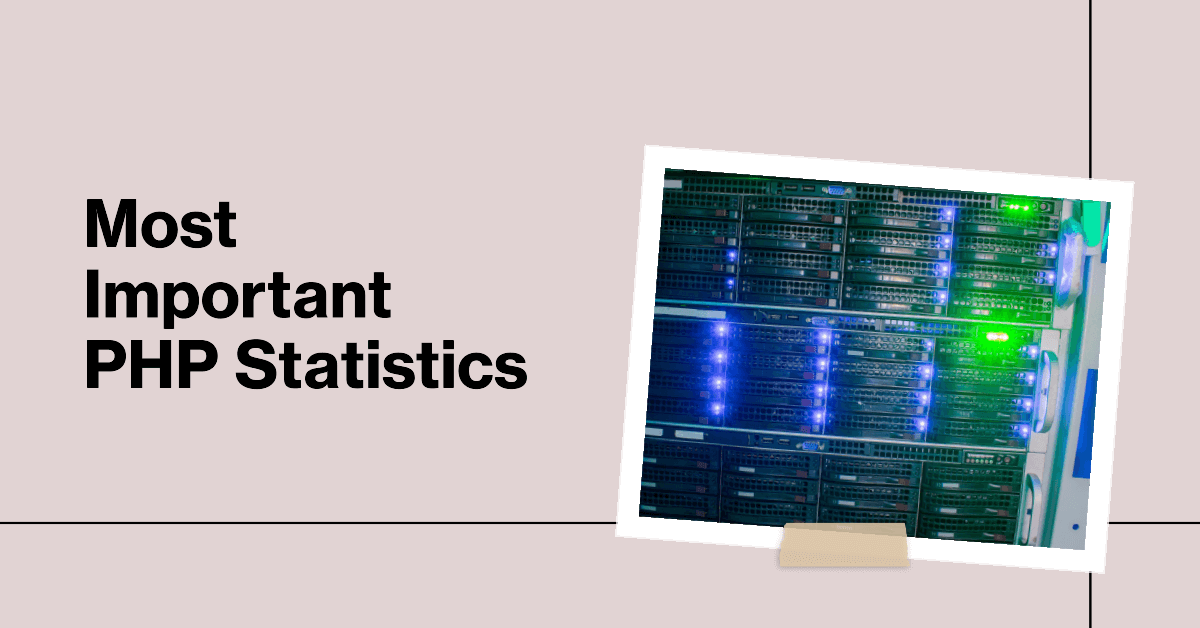There’s plenty to be said about PHP, one of the most widely used and influential scripting and server-side programming languages, but we’ll start from the beginning.
With its first official release in 1995, PHP has gained massive popularity in the past three decades. Still, its origins go back to 1993, when Rasmus Ledorf, a Danish-Canadian programmer and inventor of PHP, started working on it. Just a year after inventing it, Rasmus had PHP’s alpha versions running on his website in 1994, so he could track who viewed his resume.
Since then, PHP has been getting stable releases and has made it to version 8.2.7 at the time of writing, and today, it has a cult following. Coders love its backend and scripting capabilities, which is why PHP deserves even more recognition than it has.
Interesting PHP Facts and Stats
- Out of all websites whose server-side programming languages we know, 77.5% use PHP.
- Millions of websites use PHP, of which almost 34 million are live, with 54 million using it before.
- PHP version 7.4 is the most popular one, and it’s currently on 31.8% of all PHP websites.
- The PHP programming language powers 45% of all internet websites, as WordPress uses it.
- PHP’s market share is at 21.5%.
- 65% of all PHP websites use Nginx and Apache, accounting for 34.3% and 31.7%, respectively.
- It’s the most essential general-use programming language in the world.
- On average, PHP developers make around $95,000 a year.
- Similarly, Google’s PHP developer jobs offer a salary of nearly $200,000 a year.
- Almost 1.8 million PHP websites are based in the USA, with Germany close behind.
General PHP statistics
Now that you’ve learned about the most interesting PHP statistics, you can read ahead to learn ten more facts, as we’ve prepared a list of the 20 most intriguing PHP statistics showing this programming language’s magnitude and influence.
1. 77.5% of all websites with known server-side languages use PHP.
PHP is one of the world’s most widely used programming languages, with around four-fifths of all sites with known backend programming languages using PHP at their core.
Source: W3Techs
2. 33.7 million currently existing websites use PHP.
That 77.5% amounts to almost 34 million live websites using PHP. Moreover, nearly 54 million websites have used the PHP programming language before.
Source: BuiltWith
3. Famous companies with high-traffic websites use PHP.
Facebook, Microsoft, Mozilla, Pinterest, Tumblr, Vimeo, Wikipedia, and WordPress are only a few that utilize the power of PHP.
Source: W3Techs
4. 50.7% of PHP sites use PHP version 7.
PHP 7.0, even though it was released in 2015, is used by over half of all PHP websites, making it the most widely-used PHP version.
Source: W3Techs
5. Nearly 5.3 million websites use PHP 7.
Even if PHP version 7 was discontinued in 2018, almost 5.3 million (5,269,256 ) PHP websites still use this version of the PHP programming language.
Source: BuiltWith
6. Version 7.4 runs on 31.8% of PHP websites.
Almost 32% of all PHP websites, such as cambridge.org, psychologytoday.com, and jquery.com, run on PHP version 7.4.
Source: W3Techs
7. Version 8.0 is used by only 5.4% of PHP sites.
Compared to version 7.4, the latest major version, version 8.0 of PHP, is much less adopted and runs on only around 5.5% of all PHP websites.
Source: W3Techs
8. It powers about 45% of all internet websites.
WordPress, one of the most well-known CMS websites, which amounts to 43% of all websites, uses PHP. Furthermore, because of another two popular CMS websites, Drupal and Joomla, the numbers rise by an additional 3%, with 1.2% from Drupal and 1.8% from Joomla.
Source: W3Techs
9. PHP’s framework usage is at 21.5%.
If you look into the top 1 million websites, PHP’s framework is second only to Organization Schema, at about 21.5%.
Source: BuiltWith
10. 38.3% of PHP websites use Linux.
PHP websites run on Linux, with nearly two-fifths of all PHP websites running on this operating system, making Ubuntu its most popular iteration.
Source: W3Techs
11. Two types of web servers amount to over 65% of all PHP servers.
Approximately 34% of all PHP websites use the Nginx web server, with Apache in second place and around 31.5% of PHP websites using it.
Source: W3Techs
12. Usage-wise, PHP is in 1st place.
With nearly four-fifths of website usage, the PHP programming language has the most overall users, with ASAP.NET and Java in the 2nd and 3rd spots.
Source: W3Techs
13. Only around 26% of developers prefer PHP.
Although PHP is a popular programming language, only about a quarter of all developers prefer using it over other programming languages.
Source: Emizentech
14. GitHub says only 5.3% of pulls are PHP-related.
Even if it’s the most used programming language, GitHub shows that only around 5.3% of its pull requests in the first quarter of 2023 are PHP programs.
Source: GitHub
15. PHP developers make $95,000 on average.
The average annual salary of a PHP developer in the USA is just under $100,000, with seniors at around $110k and juniors at approximately $85k.
Source: Flexiple
16. The hourly rate of a PHP dev is about $45.
A PHP programmer can make anywhere between $30 and $70, depending on whether they’re a junior dev, an intermediate, or a senior.
Source: Flexiple
17. Google’s PHP developers make over $200k.
The highest-paying PHP developer jobs in the USA earn over $200,000 annually at Google. QuinStreet and Chegg follow behind.
Source: GlassDoor
18. Around 55% of PHP websites are in English.
Over half of PHP websites use English, while Spanish and Russian are in second and third place at around 5% each.
Source: W3Techs
19. PHP’s market share is at 21.5%.
When you look into the top one million websites, PHP has a massive lead over other programming languages and an excellent market share of over 21%.
Source: BuiltWith
20. Almost 1.8 million PHP websites are US-based.
Most PHP website servers are in the USA, while Germany is in 2nd place at 1.73m, followed by Russia at 1.4m, the UK at 1m, the Netherlands with 930,000, and France with 865,000.
Source: BuiltWith
Conclusion
PHP has broken many usage records as one of the world’s most consequential and widely used server-side programming languages. That’s why we’ve compiled a list of the top 20 PHP statistics that show the potential and magnitude of how many people and websites use it.



